British Coronations and the colour Blue
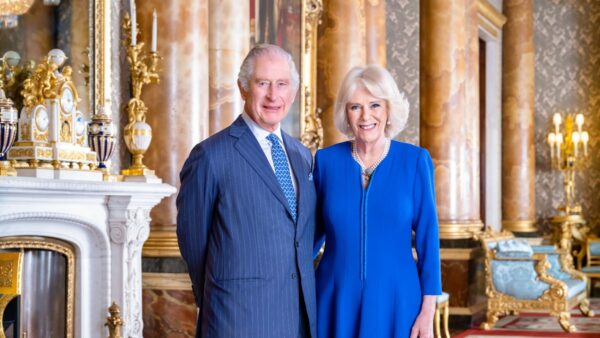
The King and Queen in the Blue Drawing Room at Buckingham Palace. Credit Hugo Burnand
The coronation of King Charles III on 6th May is nearly upon us! In recognition of this historic occasion, we thought we would investigate the rich history of British coronations and the significance of the colour blue.
The Order of the Garter at Royal Coronations
On the day of his coronation King Charles III will wear several different outfits, many of which will be in keeping with tradition. This honour of respecting tradition and heritage will also likely be true for those who will be in attendance at the Coronation, many of whom will be proudly wearing their civic medals or honours, as well as military uniforms. In anticipation of what will be worn, we will be looking at the blue flowing robes that have some of the oldest origins in royal vesture and signify the Order of the Garter .
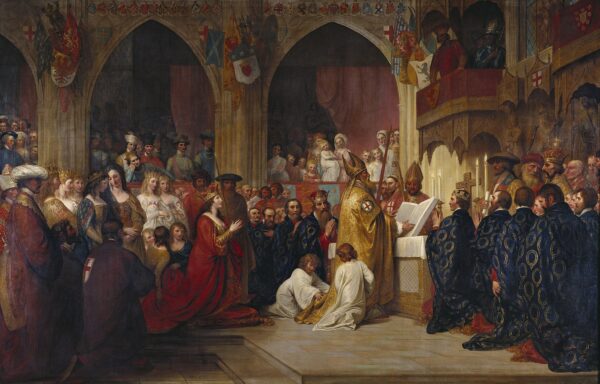
Institution of the Order of the Garter, Benjamin West, Royal Collection Trust. Painted for George III
The Knights of the Garter are the members of an order formed by King Edward III in approximately 1348, each Knight is appointed in recognition of their public service.
King Edward was greatly inspired by the legend of King Arthur and his Knights of the round table which lead him to create his own fellowship to honour those who contribute to the work of the Sovereign and the UK. The Order of the Garter has remained the highest-ranking order of chivalry for 700 years.
Since its formation in the 14th century the robes of the order have evolved and insignia have been added. However, the garter itself is believed to have always been blue.
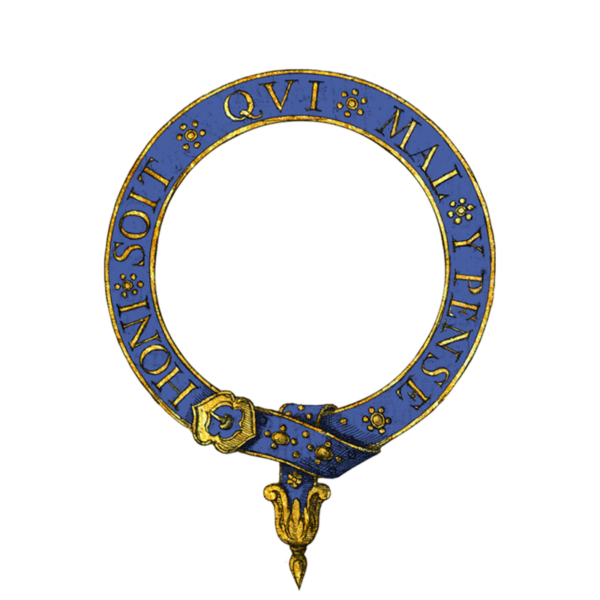
Blue Garter
One of the possible reasons why comes from a story involving King Edward’s dance partner, Joan of Salisbury. When her blue garters accidentally fell down and amused spectators, the King, in an act of chivalry, tied them to his own leg. The act of which became part of the investment of the order for new members.
The more serious explanation is that the garter was inspired by the strap used to attach pieces of armour together. Either way, the blue garter and the sumptuous navy velvet mantle which make up the Order’s ensemble is worn to this day by senior royals such as The Prince and Princess of Wales.
Coronation Collar Day
The Order of the Garter has its own annual procession in June, but we can also recognise the familiar blue robes in different ceremonies including coronations throughout art history.
The representation of the order should be no different on 6th May as King Charles’ coronation will be a “collar day”. A day on which knights of royal orders such as the Garter are allowed to wear the ceremonial chains (otherwise known as the collar) that makes up part of the order’s overall uniform.
Being such a prestigious order, King Edward III gave the colour blue a meaningful presence at coronations for the rest of history.
The Liber Regalis and the Conduct of Coronations
Another point in coronation history where we can find a prominent presence of the colour blue is within the spectacular illuminated manuscript, the Liber Regalis.
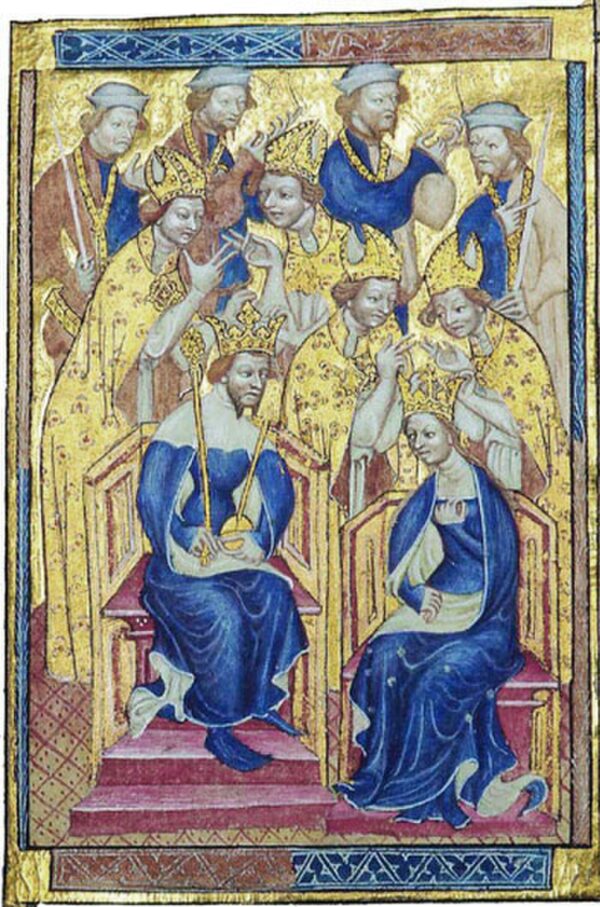
Liber Regalis, an English medieval illuminated manuscript that belongs to Westminster Abbey
Believed to have been created circa 1382 (shortly after the death of King Edward III) the manuscript bears written instructions and depictions of the correct order of conduct for a coronation ceremony.
In the beautifully painted images within the Liber Regalis the King and Queen, commonly thought to be Richard II and Anne of Bohemia, are depicted separately and then together. In each picture the sovereign is dressed predominantly in a rich blue robe with white lining.
Late Medieval Wilton House Diptych Connection
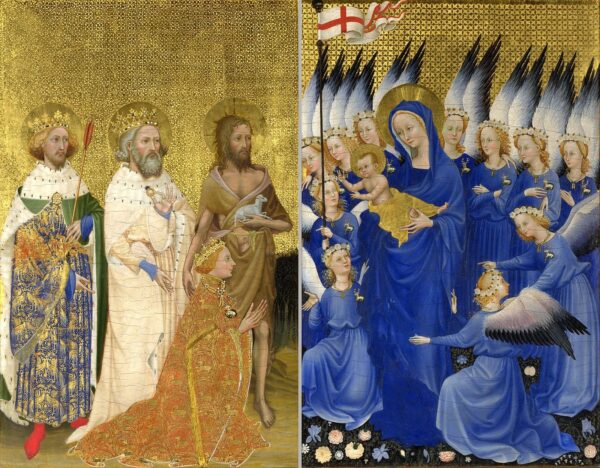
Wilton House Diptych
It has been commented that the figures in the Liber Regalis bear resemblance to those in the Wilton House Diptych, a stunning piece of medieval religious art now housed in the National Gallery. Made for Richard II, this panel painting offers imagery that is both religious and secular, and as the National Gallery writes, embodies King Richard’s ‘personal conception of Kingship.’ This perhaps further connects the strong use of blue for the King and Queen’s robes in the manuscript to sovereignty and faith.
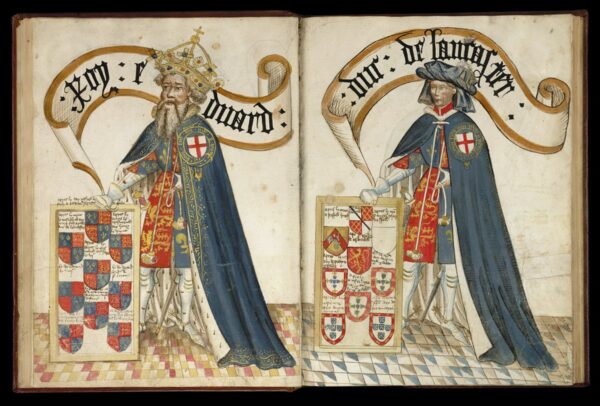
King Edward & Duke of Lancaster, Bruges Garter Book, 15th century manuscript containing portraits of the founder knights of the Order of the Garter
Another connection is the timeframe between the dates of the manuscript’s creation and the preceding King Edward’s III conception of the Order of the Garter.
Although some sources say that the original colour of the Order’s robe was purple, as we can see in the portrait above, these robes appear to be very much blue. This painting of King Edward III and the Duke of Lancaster, dates from c.1450 from the Bruges Garter Book (the earliest register of the Order).
This may be a coincidence and without greater study we can only speculate over the likeness between the regent’s robes in the Liber Regalis and the blue mantle of the Order of the Garter. However, it would be nice to think that the ceremonial robes in the volume were influenced by the chivalrous fellowship’s rich blue uniform.
The King’s Coronation
The ceremonies and processions which will make up King Charles’ coronation are set to be shorter than that of the late Queen Elizabeth’s in 1953, and with apparently a more subtle dress code, meaning the vestments of the Garter may, or may not, be seen in their full glory. We encourage you though to look out for the unmistakable navy blue mantles, should they appear on the day!